The Rehabilitation of the Historical Bridge of Konitsa, Epirus, Greece: A Documentation-Based Methodology of Structural Analysis and Rehabilitation Strategy
Abstract
:1. Introduction
2. Brief Description of the Bridge and Review of Documentation
3. Bridge Pathology
- Oblique cracks in the lower region of the south abutmentInclined cracks are observed passing through mortar joints and through stones. More specifically, cracks through the mortar joints are witnessed by the white-coloured mortar used for re-pointing, applied in 2017, Figure 8. The cracks in the stones are numbered (two of them are shown in close-up photos in the same Figure 8), while their widths range between 0.2 mm and 1.2 mm. The inclined cracks are directed from the upstream springing of the arch to the downstream base of the south abutment.
- Cracks in the arch stones at the region of its springingAlmost vertical cracks are observed in the end stones of the main arch, at its intrados, in two locations, namely, in the downstream region of the south abutment, underneath the first transverse iron tie (Figure 9a), as well as at the base of the abutment (Figure 9b). Cracks of the same morphology are detected in the end stones of the arch, at the north abutment, in the region underneath the first iron connector (Figure 9c,d). In some cases, as shown in Figure 9c, there are stones detached from the arch.
- Vertical cracks in the spandrel walls
- Missing stones at the foundation of the north abutmentAlthough the north abutment is founded on rock, leveling works were needed to create a horizontal plane for the construction of the bridge. This was achieved through local filling using small-sized stones (Figure 11). Due to the hydraulic conditions in the area, some of the stones were detached and are missing.
- The state of the 1913 repaired regionThe major structural problem of the bridge is the poor condition of the RC jacket constructed at the intrados of the main arch, in the region of its crown (Figure 12), as part of the after-explosion repair of the bridge in 1913 [25]. The jacket, 100 mm to 120 mm thick, is provided with longitudinal reinforcement, consisting of eleven bars, 24 mm in diameter. Transverse bars, 14 mm in diameter were arranged, and spaced at approximately 150 mm. The grid of longitudinal and transverse bars is anchored to the arch, at its intrados, using steel hangers either wedged between stones of the arch or anchored to the plain concrete of the extrados. Smooth bars with handmade protrusions for an improved bond with the concrete were used. The RC jacket presents very advanced corrosion of the reinforcement, with a significant reduction in the bars’ diameter and disintegration of the concrete, as shown in Figure 13. Therefore, the structural function of the RC jacket is no longer fulfilled. To make a decision on whether reconstruction of the disintegrated RC jacket is needed, it is necessary to identify the reason for which that intervention was applied, and if its rationale is justified.
4. Building the Numerical Model of the Bridge
4.1. Mechanical Properties of the Masonry
- → denotes the mean compressive strength of the masonry (MPa);
- → denotes the mean compressive strength of the stones (MPa);
- → denotes the mean compressive strength of the mortar (MPa);
- → factor depends on the bond between the stones and the mortar (=0.60 for rubble stones);
- → factor depends on the type of masonry (=2.50 MPa for rubble stone masonry);
- → denotes the ratio between the mortar and the masonry volume (≥0.30).
4.2. Assumptions Related to the Foundation Soil
4.3. Timber Elements in the Abutments and in the Arch
5. Documentation-Based Calculation Methodology
The Bridge under Its Self-Weight-Phases Considered in Calculations
6. The Structural Behaviour of the Bridge—The Effect of the Examined Phases
6.1. Phase 1—Construction of Abutments and Portions of the Arch
6.2. Phase 2—Construction of the Central Region of the Arch (Bridge Completed)
6.3. Phase 3—Damage Due to Explosion (1913)
6.4. Phase 4—Repair of the Bridge (1913)
7. The Structural Role of the RC Jacket at the Intrados of the Arch
7.1. The Influence of Flow Pressures
7.2. The Influence of Earthquakes
- (a)
- Eigenvalue analysis, with the purpose of qualitatively identifying the most critical modes for the seismic behaviour of the bridge. To this purpose, the as-built bridge is modelled, before the 1913 damage. The results of this analysis are shown in Figure 35, where the modes with the most significant contribution are presented. The results show that the most critical direction is the transverse one, out-of-plane of the bridge, with the contribution factor of the translational first mode being close to 50%. This is the reason why only results concerning the seismic action in the transverse direction are presented herein. This is more so because the effect of the RC jacket at the intrados is investigated;
- (b)
- Equivalent static analysis for the conventional seismic action resulting from the current Seismic Code, assuming a q-factor equal to unity. The conventional seismic action is imposed on the numerical model representing the repaired bridge, excluding the RC jacket. The results, presented in Figure 36, show that the tensile stresses developing in the damaged and, subsequently, repaired region of the arch are by far larger than any value that could be assumed for the bond between the arch and the added plain concrete. This proves that the RC jacket at the intrados, thanks to its longitudinal reinforcement, is needed to undertake the tension due to the transverse action of an earthquake. It seems that, on the contrary, the developed compressive stresses can be resisted by both the arch and the plain concrete. Another interesting, although qualitative result, is related to the tensile and compressive stresses calculated at the base of the two abutments. As shown in Figure 36, the tensile or compressive stresses develop in the same face of the two abutments. This is an observation that confirms the interpretation of the damage (presented in Section 6.3), attributed to the 1913 explosion. The numerical values of the compressive stresses at the base of the abutments are significantly smaller than the compressive strength of the masonry (=14.50 MPa, Table 1), while the tensile stresses seem to be far beyond the tensile strength of the mortar. Nonetheless, as shown in Figure 37, the peak tensile stresses occur in the smaller dimensions section of the north abutment, while they are very much localised;
- (c)
- Although the purpose of the numerical calculations considering the seismic action was neither to design the bridge nor to upgrade its seismic resistance, the results show that some damage is to be expected under the design earthquake;
- (d)
- In conclusion, the results of the numerical analyses, although oversimplified, allow for the structural function of the RC jacket to be qualitatively identified. As shown in Figure 38, during a seismic event, the portion of the unreinforced concrete at the extrados of the arch subjected to compression collaborates with the masonry arch, whereas the concrete portion belonging to the tensioned zone of the section risks being detached from the masonry arch. Therefore, it is sensible to assume that the RC jacket, thanks to its reinforcement, can prevent the occurrence of cracks in the tensioned zone or keep their openings to an acceptable value.
7.3. Rehabilitation Measures
8. Conclusions
- The exhaustive documentation of the bridge offers a sound basis for the understanding of its behaviour and, by way of consequence, for the formulation of protective measures for its preservation. The validity of this conclusion can be extended to all historical constructions and monuments;
- The structural history of the bridge, based on historical sources, as well as “imprinted” on the construction itself, has dictated a methodology of numerical calculations following the construction phases of the monument step-by-step, as well as the effects of the major event of its man-induced damage one century ago. It was documented that if this step-by-step procedure had not been followed, the action–effects (stresses and deformations) would have been unrealistic, and it would have been impossible to interpret the damage to and the behaviour of the bridge. This step-by-step procedure was also dictated by the pronounced geometrical asymmetry of the bridge, as well as by the significantly different conditions of the foundation soil in the two abutments. It is, therefore, adequate for other arch bridges too that present similar asymmetries;
- A series of parametric analyses of the geometrically accurate numerical model, although elastic and, hence, simplified, have allowed for the effect of the timber grids within the solid abutments to be interpreted, for the observed damage to be numerically confirmed and for the structural role of the RC jacket at the intrados of the bridge to be understood;
- Based on the entire work, the large margin of safety of the bridge under its self-weight, as well as against flood was proven. The simplified investigation of the seismic behaviour of the bridge, dictated by the constraints related to the allowable interventions, has shown that the bridge meets the current Code requirements for a design earthquake, although some local damage is to be expected;
- The approved scheme of interventions includes measures that alter neither the structural system of the bridge nor its appearance. More specifically, the RC jacket at the intrados is reconstructed using durable materials, the surveyed cracks are grouted and the foundation of the bridge is protected against scouring;
- A final conclusion is related to the treatment of interventions using concrete (plain or reinforced) quite frequently applied to historical stone bridges in the past. Although nowadays, in conformity with international Charters, such interventions would not be acceptable, it is to be admitted that the repair of the bridge of Konitsa by the engineers of the French Army has contributed to the survival of the bridge. Nonetheless, as the durability of the early concretes is questionable, the modern engineer is asked to either protect the in situ concrete or replace it with durable materials compatible with the original ones.
Author Contributions
Funding
Data Availability Statement
Acknowledgments
Conflicts of Interest
References
- Casarin, F.; Bellin, S.; Mocellini, M.; Fabris, R. Static and seismic assessment of Ponte delle Capre, a masonry arch bridge. In Life-Cycle of Structures and Infrastructure Systems; Biondini, F., Frangopol, D.M., Eds.; Taylor & Francis: London, UK, 2023; pp. 1323–1330. [Google Scholar] [CrossRef]
- Di Prisco, M.; Scola, M.; Zani, G. On site assessment of Azzone Visconti bridge in Lecco: Limits and reliability of current techniques. Constr. Build. Mater. 2019, 209, 269–282. [Google Scholar] [CrossRef]
- Lubowiecka, I.; Arias, P.; Riveiro, B.; Solla, M. Multidisciplinary approach to the assessment of historic structures based on the case of a masonry bridge in Galicia (Spain). Comput. Struct. 2011, 89, 1615–1627. [Google Scholar] [CrossRef]
- Martinelli, P.; Galli, A.; Barazzetti, L.; Colombo, M.; Felicetti, R.; Previtali, M.; Roncoroni, F.; Scola, M.; Prisco, M. Bearing capacity assessment of a 14th century arch bridge in Lecco (Italy). Int. J. Archit. Herit. 2018, 12, 237–256. [Google Scholar] [CrossRef]
- Aydin, A.C.; Ozkaya, S.G. The finite element analysis of collapse of single-spanned historic masonry arch bridges (Ordu Sarpdere Bridge). Eng. Fail. Anal. 2018, 84, 131–138. [Google Scholar] [CrossRef]
- Costa, C.; Arêde, A.; Morais, M.; Aníb, A. Detailed FE and DE modelling of stone masonry arch bridges for the assessment of load-carrying capacity. Procedia Eng. 2015, 114, 854–861. [Google Scholar] [CrossRef]
- Franck, S.A.; Bretscneider, N.; Slowik, V. Safety analysis of existing arch bridges by nonlinear finite element simulations. Int. J. Damage Mech. 2020, 29, 126–143. [Google Scholar] [CrossRef]
- Frunzio, G.; Monaco, M.; Gesualdo, A. 3D F.E.M. analysis of a Roman arch bridge. In Proceedings of the Historical Constructions, Guimaraes, Portugal, 7–9 November 2001; pp. 591–598. [Google Scholar]
- Karalar, M.; Yesil, M. Implications of Arch Warp Altitudes on an Ancient Masonry Bridge under Ground Movements. Appl. Sci. 2023, 13, 7395. [Google Scholar] [CrossRef]
- Zani, G.; Martinelli, P.; Galli, A.; Prisco, M. Three-dimensional modelling of a multi-span masonry arch bridge: Influence of soil compressibility on the structural response under vertical static loads. Eng. Struct. 2020, 221, 110998. [Google Scholar] [CrossRef]
- Bayraktar, A.; Altunisik, A.C.; Birinci, F.; Sevim, B.; Turker, T. Finite-Element Analysis and Vibration Testing of a Two-Span Masonry Arch Bridge. J. Perform. Constr. Facil. 2010, 24, 46–52. [Google Scholar] [CrossRef]
- Costa, C.; Ribeiro, D.; Silva, P.; Arede, A.; Calcada, R. Calibration of the numerical model of a stone masonry railway bridge based on experimentally identified modal parameters. Eng. Struct. 2016, 123, 354–371. [Google Scholar] [CrossRef]
- Borlenghi, P.; Saisi, A.; Gentile, C. Effects of changing temperature in the vibration-based model updating of a masonry bridge. In Life-Cycle of Structures and Infrastructure Systems; Biondini, F., Frangopol, D.M., Eds.; Taylor & Francis: London, UK, 2023; pp. 1552–1559. [Google Scholar] [CrossRef]
- Toth, A.R.; Orban, Z.; Bagi, K. Discrete element analysis of a stone masonry arch. Mech. Res. Commun. 2009, 36, 469–480. [Google Scholar] [CrossRef]
- Lourenço, P.B.; Hunegn, T.; Medeiros, P.; Peixinho, N. Testing and analysis of masonry arches subjected to impact loads. In Proceedings of the ARCH’10—6th International Conference on Arch Bridges, Fuzhou, China, 11–13 October 2010; pp. 603–610. [Google Scholar]
- Drosopoulos, G.A.; Stavroulakis, G.E.; Massalas, C.V. Limit analysis of a single span masonry bridge with unilateral frictional contact interfaces. Eng. Struct. 2006, 28, 1864–1873. [Google Scholar] [CrossRef]
- Kiyono, J.; Furukama, A. Seismic Assesment of Stone Arched Bridges. In Proceedings of the 15th World Conference on Earthquake Engineering, Lisboa, Portugal, 24–28 September 2012. [Google Scholar]
- Proske, D.; Gelder, P. Safety of Historical Stone Arch Bridges, 1st ed.; Springer: Berlin/Heidelberg, Germany, 2009; pp. 99–163. ISBN 978-3-540-77616-1. [Google Scholar] [CrossRef]
- Scheibmeir, E. Nonlinear Seismic Analysis of a Masonry Arch Bridge. Master’s Thesis, Universitat Politècnica de Catalunya, Barcelona, Spain, 2012. [Google Scholar]
- Bencardino, F.; Curto, R.; Scavelli, V. Inspection and Structural Rehabilitation of an Existing Masonry Arch Railway Bridge. Appl. Sci. 2023, 13, 2973. [Google Scholar] [CrossRef]
- Li-Ling, Y.; Zhi-Qian, D.; Gang, L. Simplified mechanical models for the seismic collapse performance prediction of unreinforced masonry structures. Eng. Struct. 2022, 258, 114131. [Google Scholar] [CrossRef]
- Pelà, L.; Aprile, A.; Benedetti, A. Seismic assessment of masonry arch bridges. Eng. Struct. 2009, 31, 1777–1788. [Google Scholar] [CrossRef]
- Pelà, L.; Aprile, A.; Benedetti, A. Comparison of seismic assessment procedures for masonry arch bridges. Constr. Build. Mater. 2013, 38, 381–394. [Google Scholar] [CrossRef]
- Saygili, O.; Lemos, J.V. Influence of site effects on the seismic vulnerability of masonry arch bridges. In Life-Cycle of Structures and Infrastructure Systems; CRC Press: Boca Raton, FL, USA, 2023; pp. 1523–1529. [Google Scholar] [CrossRef]
- Palieraki, V.; Oikonomopoulou, E.; Nikolopoulou, V.; Vintzileou, E.; Giannelos, C. The Historical Bridge of Konitsa-Epirus, Greece: Documentation of the Structural System. Int. J. Archit. Herit. 2022, 17, 1446–1463. [Google Scholar] [CrossRef]
- Michaelidis, G. Technical Report of Geodetic, Topographic and Photogrammetric Survey on the Arched Bridge of Konitsa; Service of Modern Monuments and Technical Works of Epirus: North Ionian and West Macedonia, Greece, 2017. (In Greek) [Google Scholar]
- Goutos, C. Old Bridges in our province. Konitsa Mag. 2014, 179, 419. (In Greek) [Google Scholar]
- Giannelos, C.; Plainis, P.; Vintzileou, E. The historical bridge of Plaka: Interpretation of structural behavior and collapse. Eng. Fail. Anal. 2023, 153, 107589. [Google Scholar] [CrossRef]
- Giannelos, C.; Vintzileou, E. The Rehabilitation of the Historical Bridge of Konitsa: A Documentation-Based Investigation of Structural Behaviour. In Proceedings of the PROHITECH 2021, Athens, Greece, 25–27 October 2021; Vayas, I., Mazzolani, F.M., Eds.; Lecture Notes in Civil Engineering. Springer: Berlin/Heidelberg, Germany, 2009. [Google Scholar]
- SOFiSTiK. Finite Element Method Software, version 14.14-30; Sofistik AG: Nürnberg, Germany, 2014. [Google Scholar]
- EN 1996-1-1: 2005; Eurocode 6: Design of Masonry Structures—Part 1-1: General Rules for Reinforced and Unreinforced Masonry structures. European Committee for Standardization: Brussels, Belgium, 2005.
- Tassios, T.P.; Chronopoulos, M. Aseismic Dimensioning of Interventions on Low Strength Masonry Buildings. In Proceedings of the Middle East and Mediterranean Regional Conference on Low-Strength Masonry in Seismic Areas, Ankara, Turkey, 31 August—6 September 1986; Middle East University: Ankara, Turkey, 1986. [Google Scholar]
- Tassios, T.P.; Mamillan, M. Valutazione Strutturale dei Monumenti Antichi, 1st ed.; Edizione Kappa: Roma, Italy, 1985. [Google Scholar]
- Vintzileou, E. Three-Leaf Masonry in Compression, before and after Grouting: A Review of Literature. Int. J. Archit. Herit. Conserv. Anal. Restor. 2011, 5, 513–553. [Google Scholar] [CrossRef]
- EN 1995-1-1: 2004; Eurocode 5: Design of Timber Structures—Part 1-1: General—Common Rules and Rules for Buildings. European Commission for Standardization: Brussels, Belgium, 2004.
- NTUA Research Team. Restoration of the Konitsa Stone Bridge. Research Report 2018. (In Greek)
- Epirus—Konitza the Bridge © Boissonnas Archive. Hellenic Ministry of Culture; Copyright: MOMus-Museum of Photography of Thessaloniki: Thessaloniki, Greece; Available online: https://www.nhmuseum.gr/en/departments/into-the-museum-s-collection/item/8648-bridgeinepirusphotographiccopyfromaglassplateoffredboissonnasc1903-1923theglassplateisatthemuseumofphotographyinthessaloniki (accessed on 15 January 2024).
- ISCARSAH Guidelines for the analysis, conservation and structural restoration of architectural heritage. Unpublished work, 2024.
- Hellenic Ministry of Culture. Regulatory framework for the preparation of studies and the execution of works on immovable monuments. Off. Gov. Gaz. 2019, 2837/Β/5-7-2019. (In Greek) [Google Scholar]
- Rhomaides, A.; Zeitz, F. Balkan Wars 1912–1913 (Photographic Album), 2nd ed.; Kedros Publishing: Athens, Greece, 2008; ISBN 978-960-04-1683-1. [Google Scholar]
- NTUA Interdisciplinary Research Team. The Bridge of Plaka: The NTUA Work for Its Restoration; National Technical University of Athens: Athens, Greece, 2018; ISBN 978-618-82612-4-2. (In Greek) [Google Scholar]
- Institute of Engineering Seismology and Earthquake Engineering, Catalog of Seismicity of the Greek Area, Research Project Helpos. 20 September 2021. Available online: https://www.itsak.gr/db/data (accessed on 15 January 2024).
- EPPO (Earthquake Planning and Protection Organization). Hellenic Seismic Code (EAK 2000); Ministry of Environment Planning and Public Works: Athens, Greece, 2003. [Google Scholar]


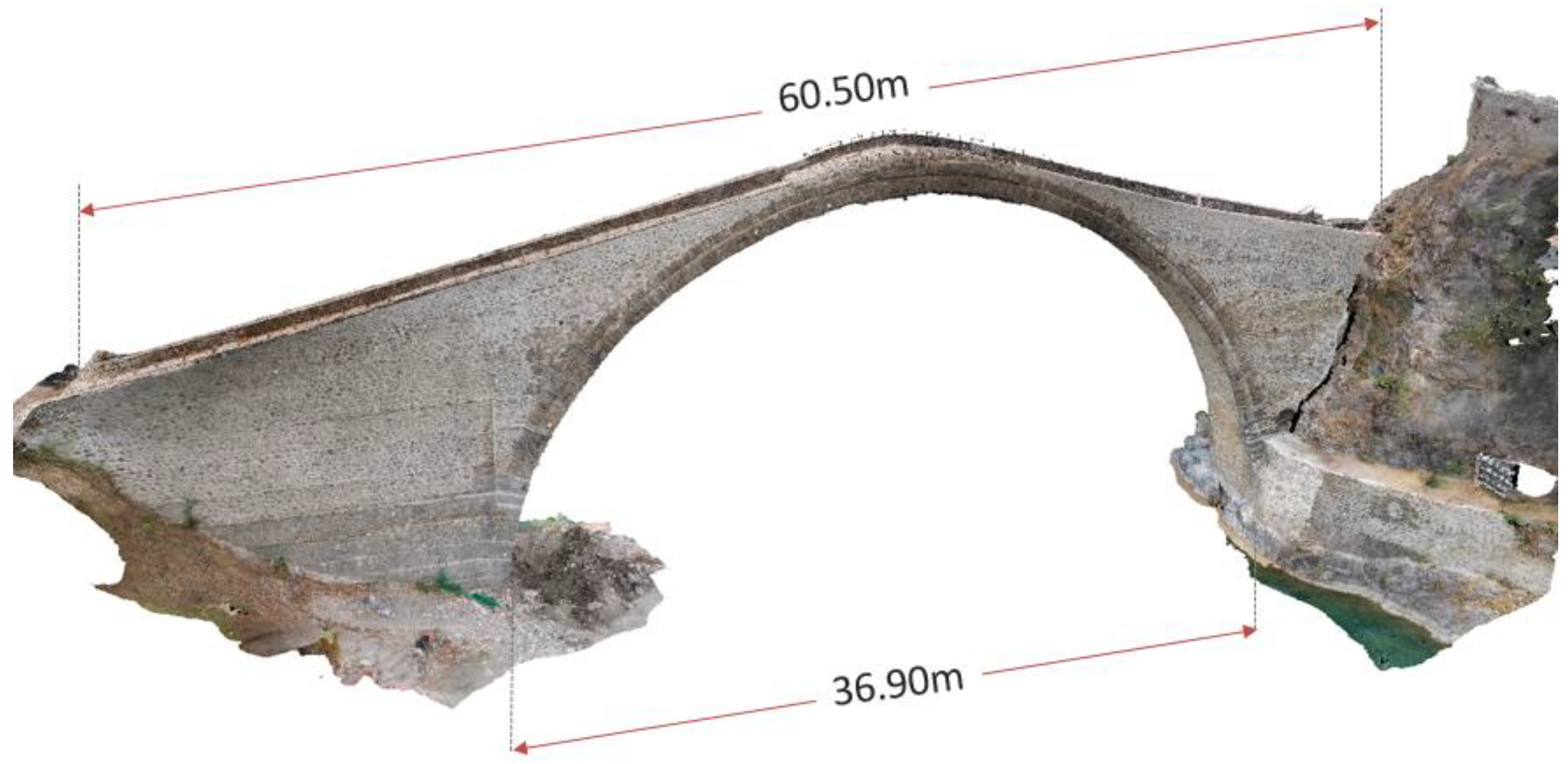




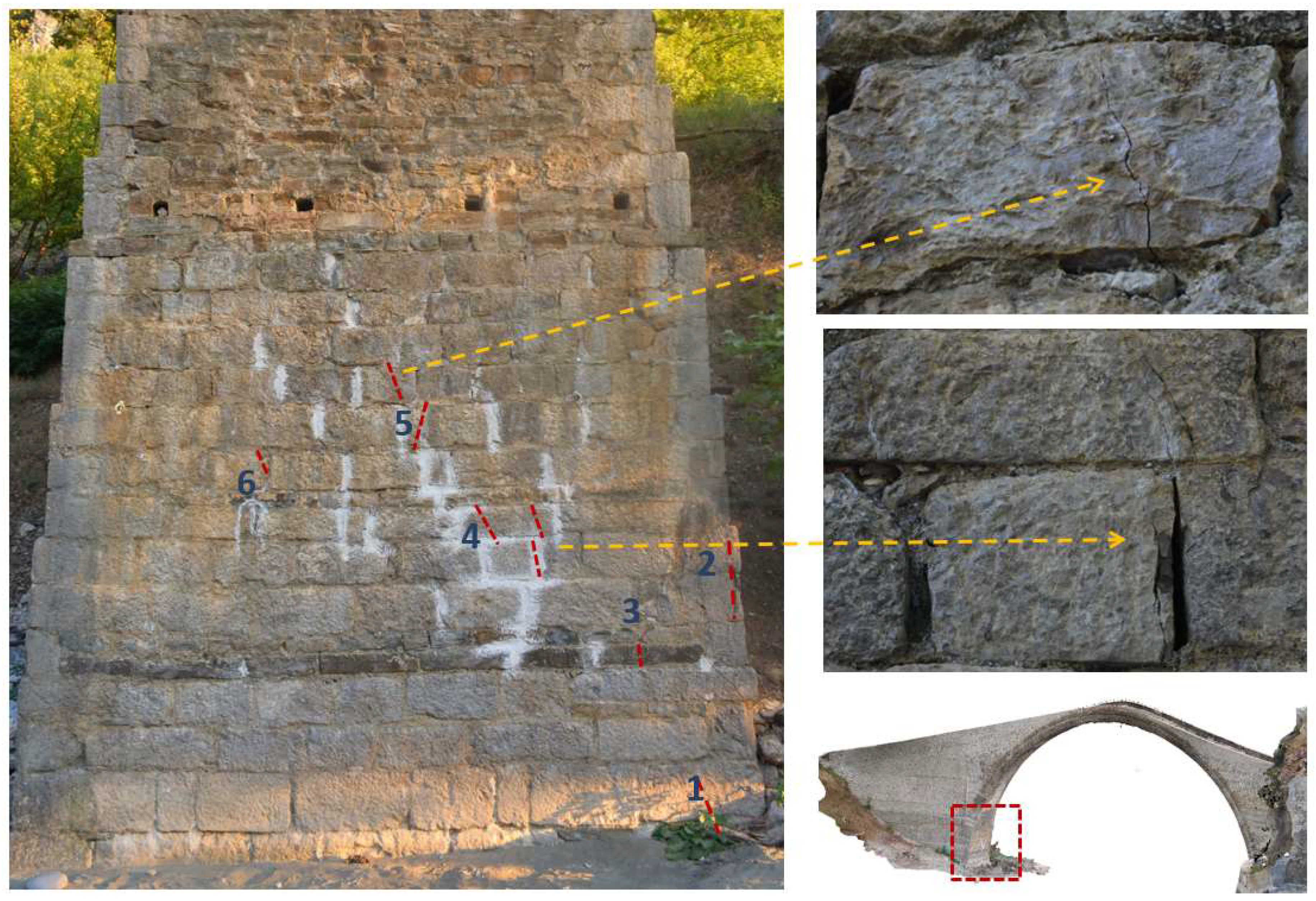
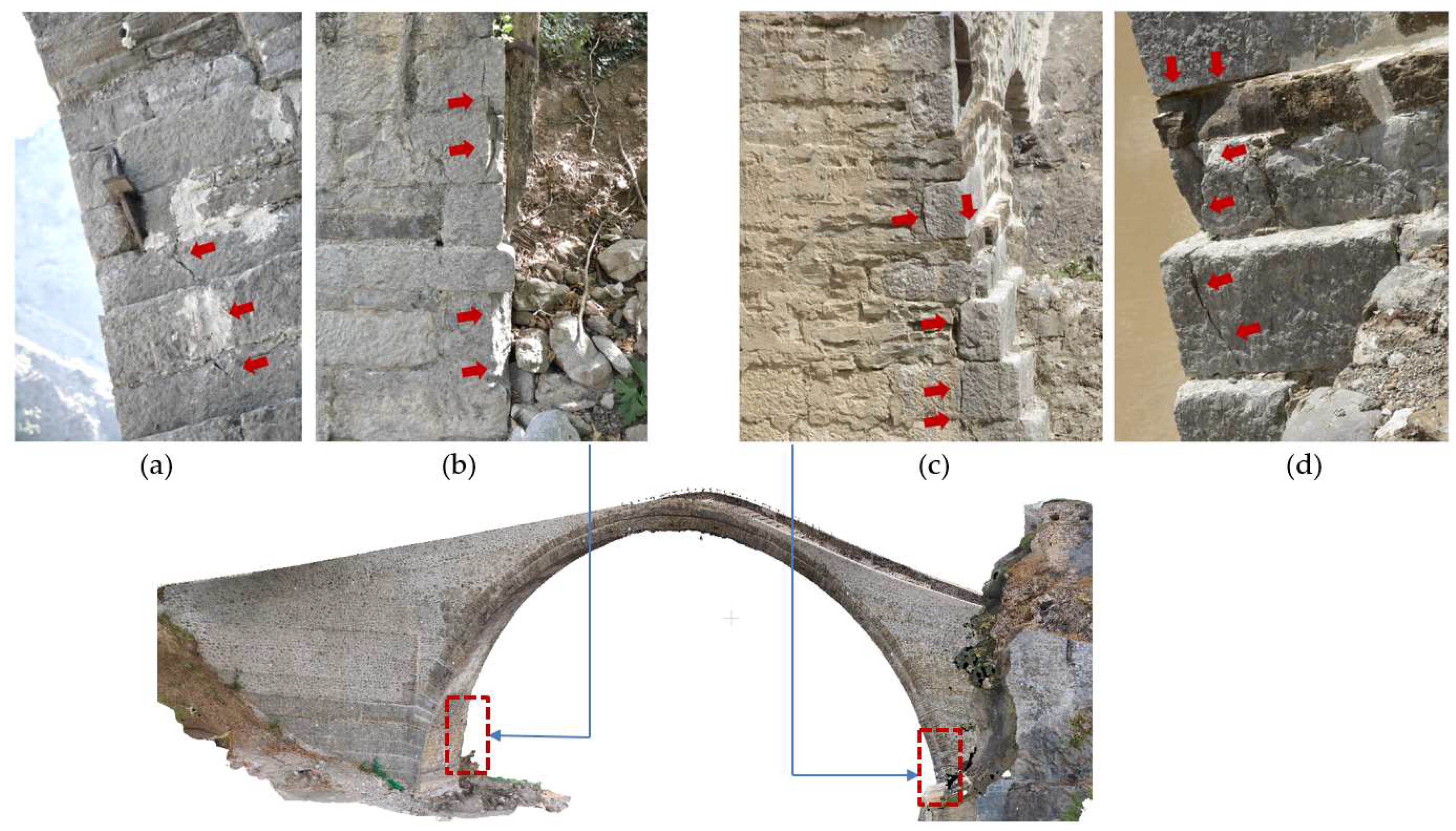

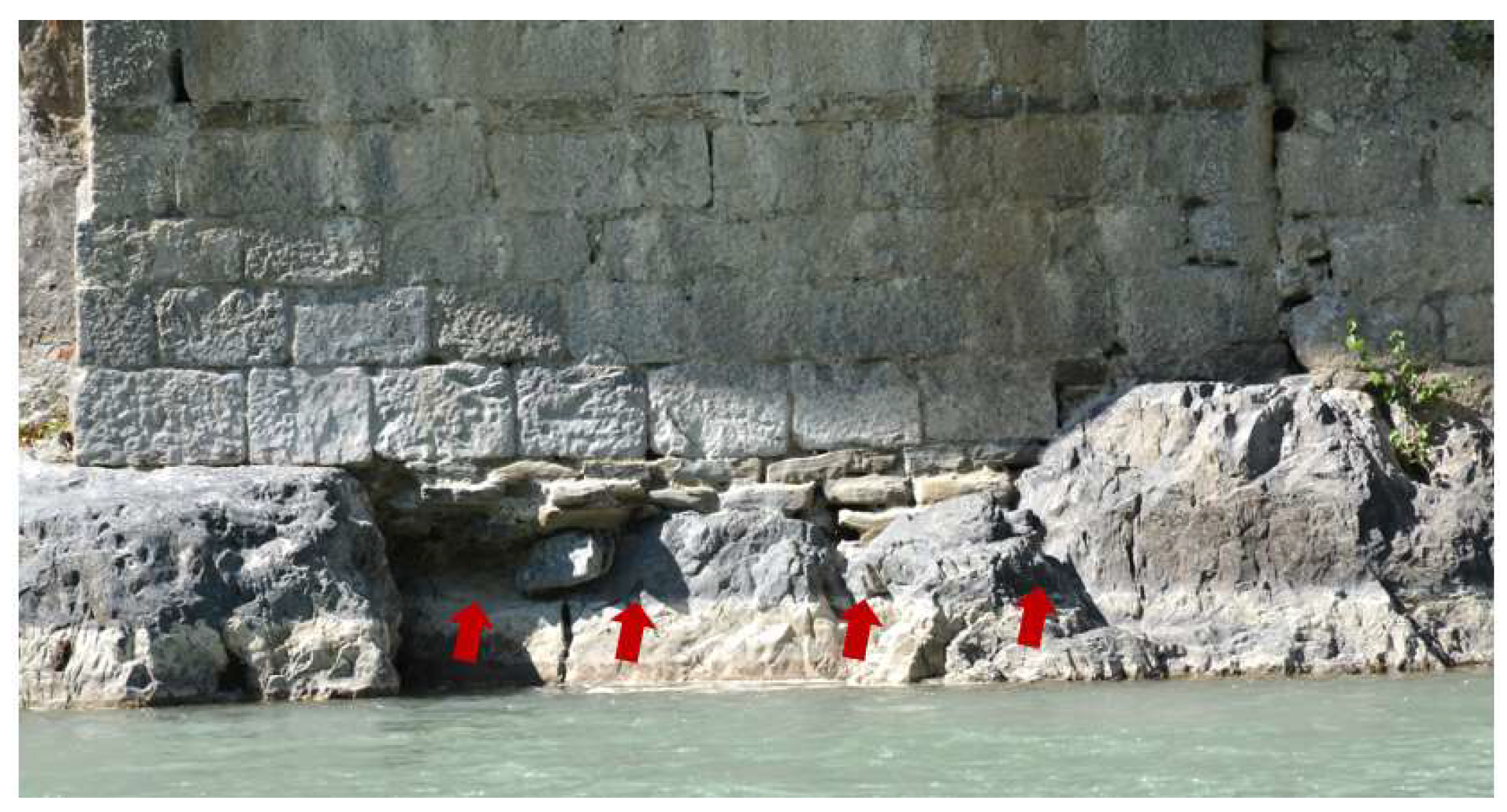




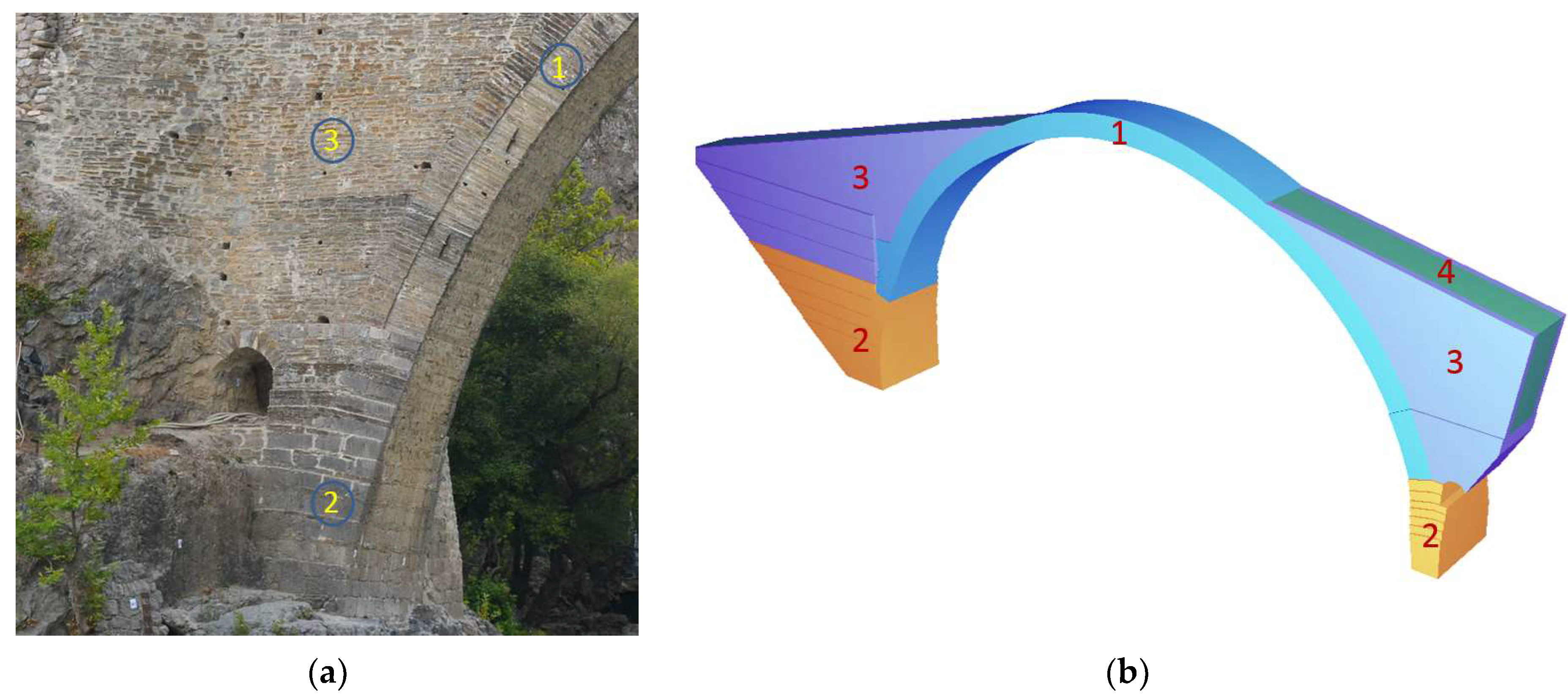

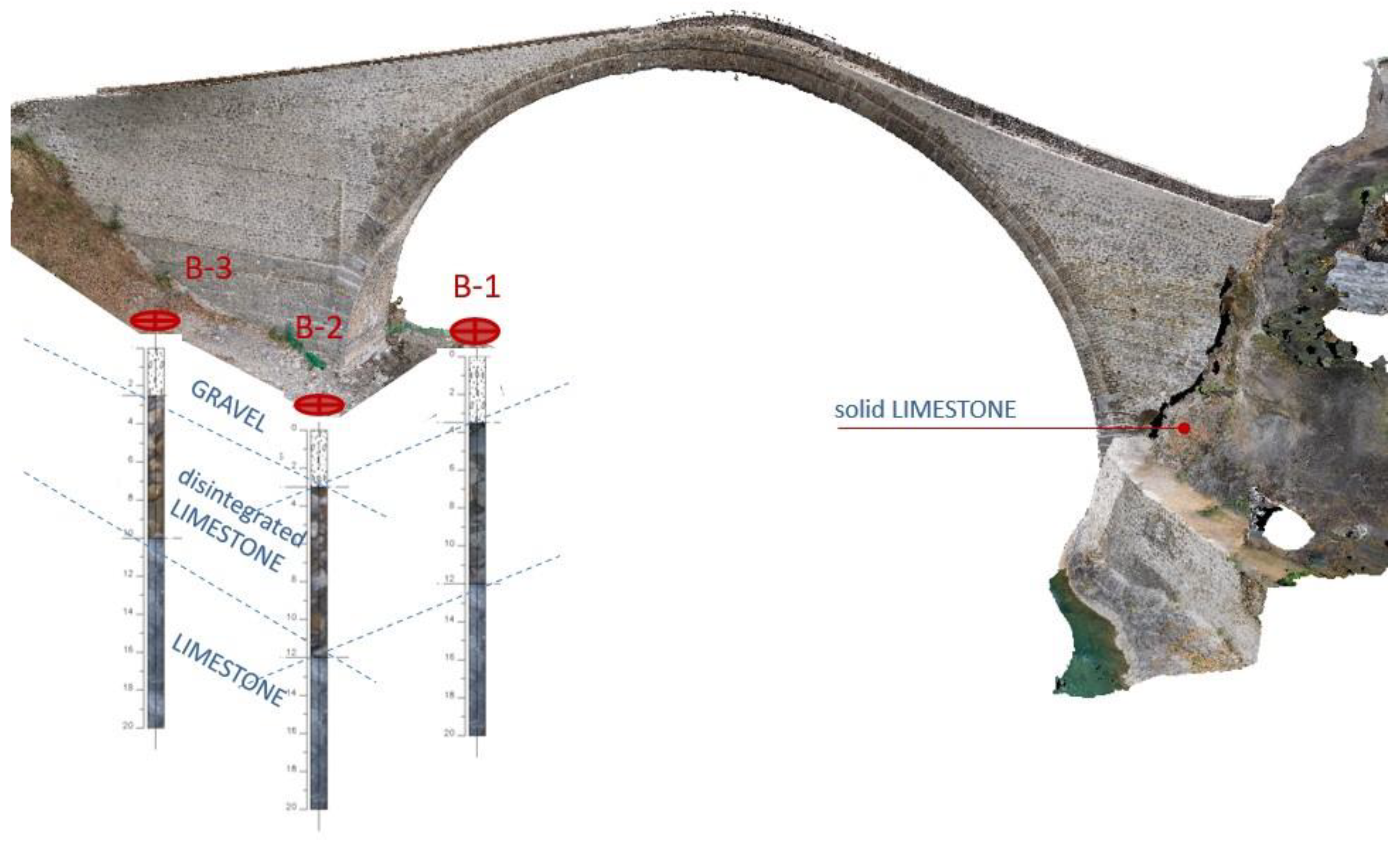
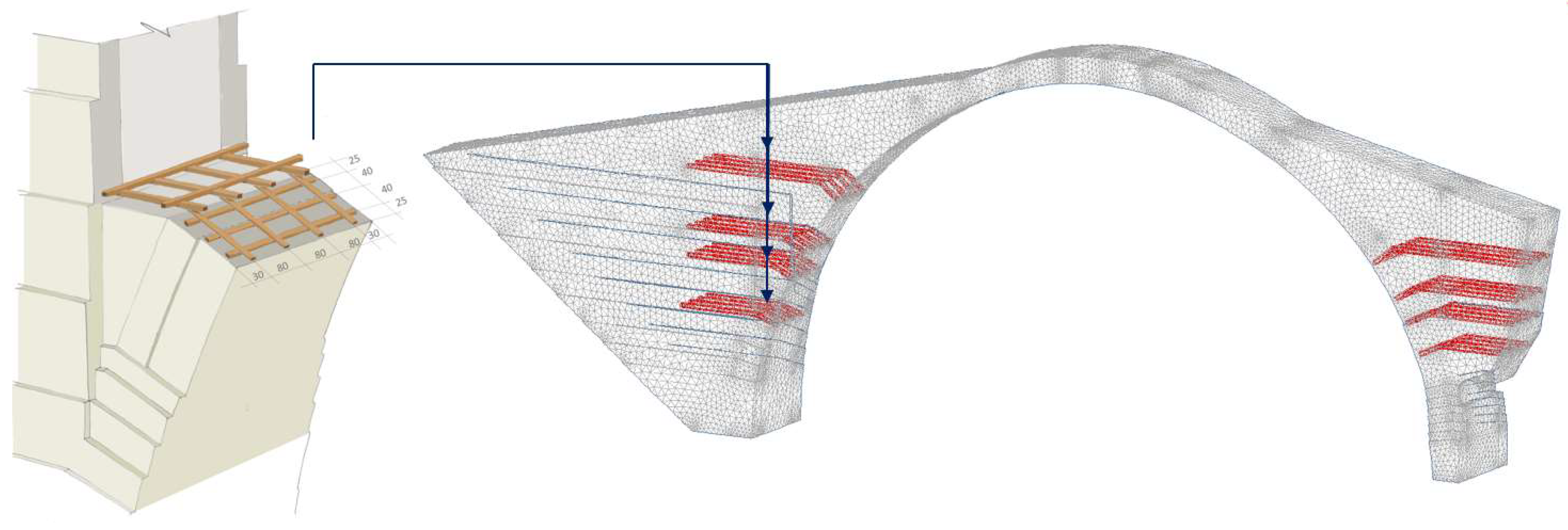
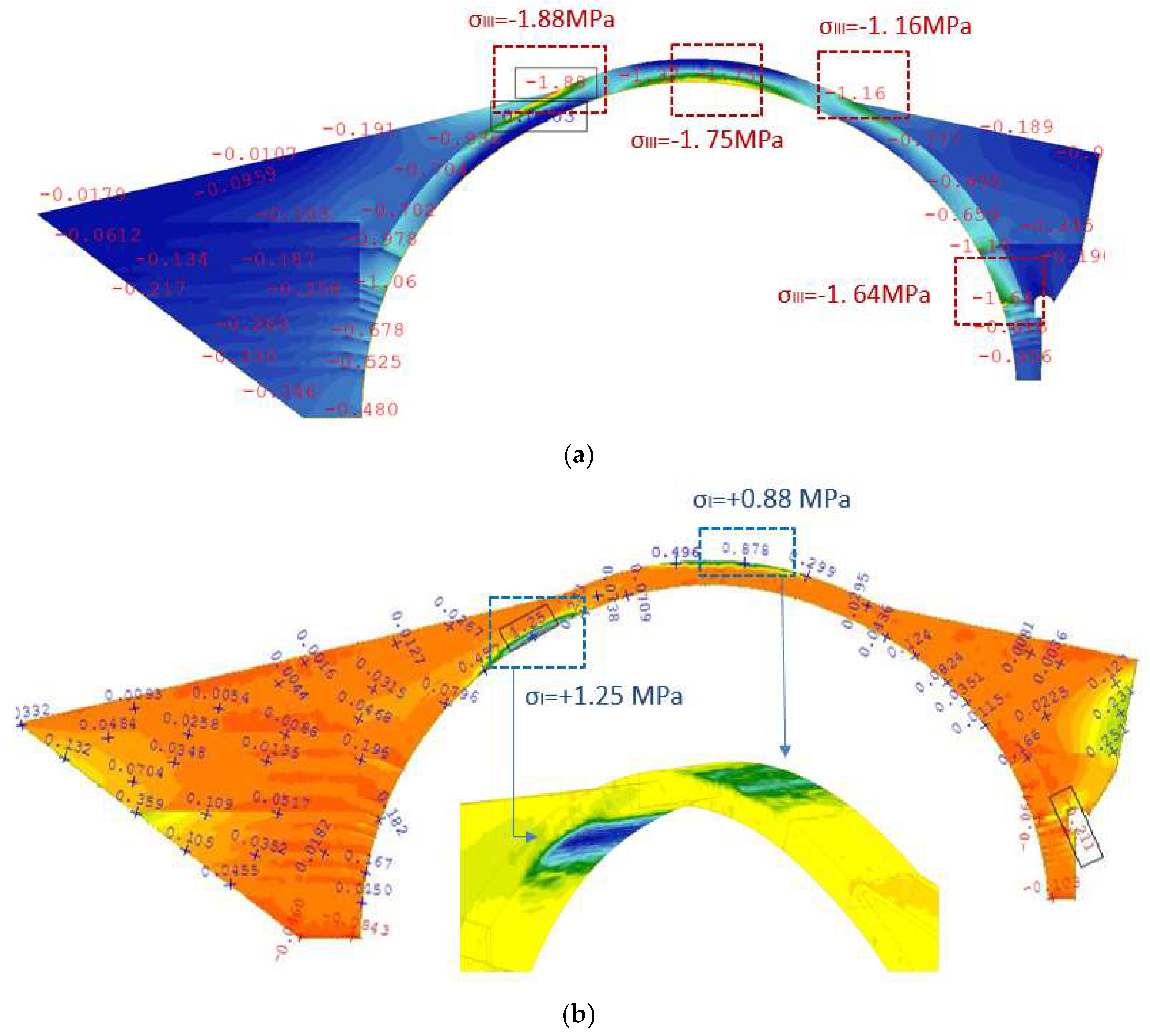
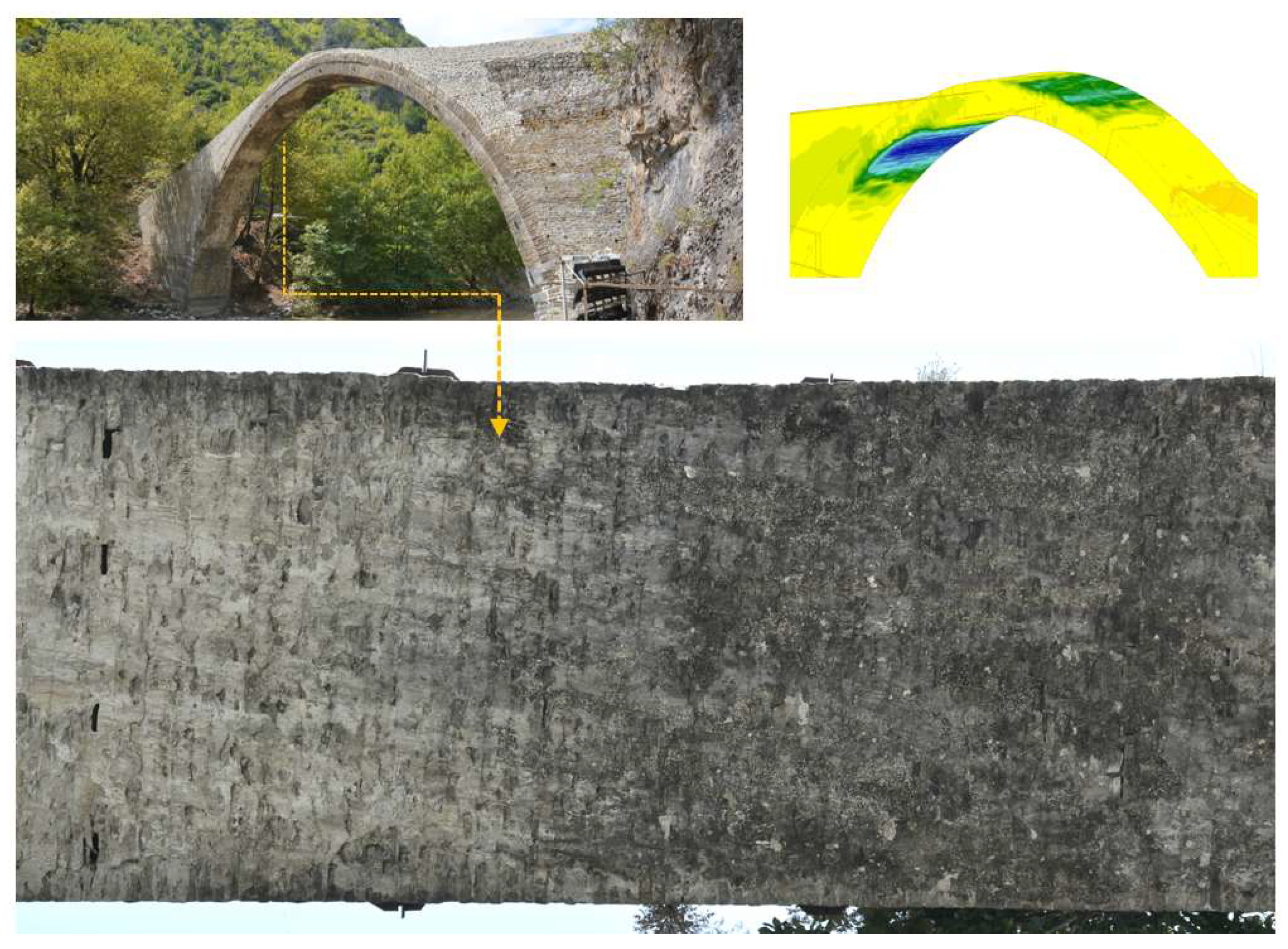



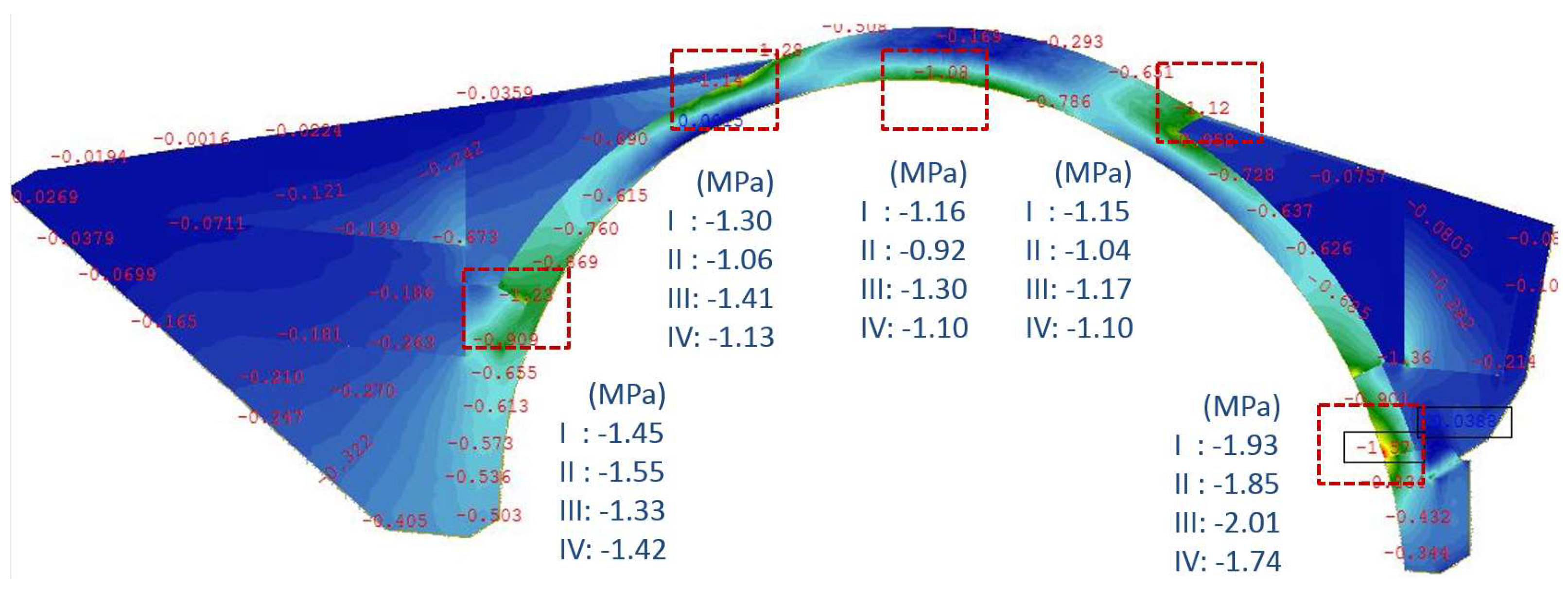


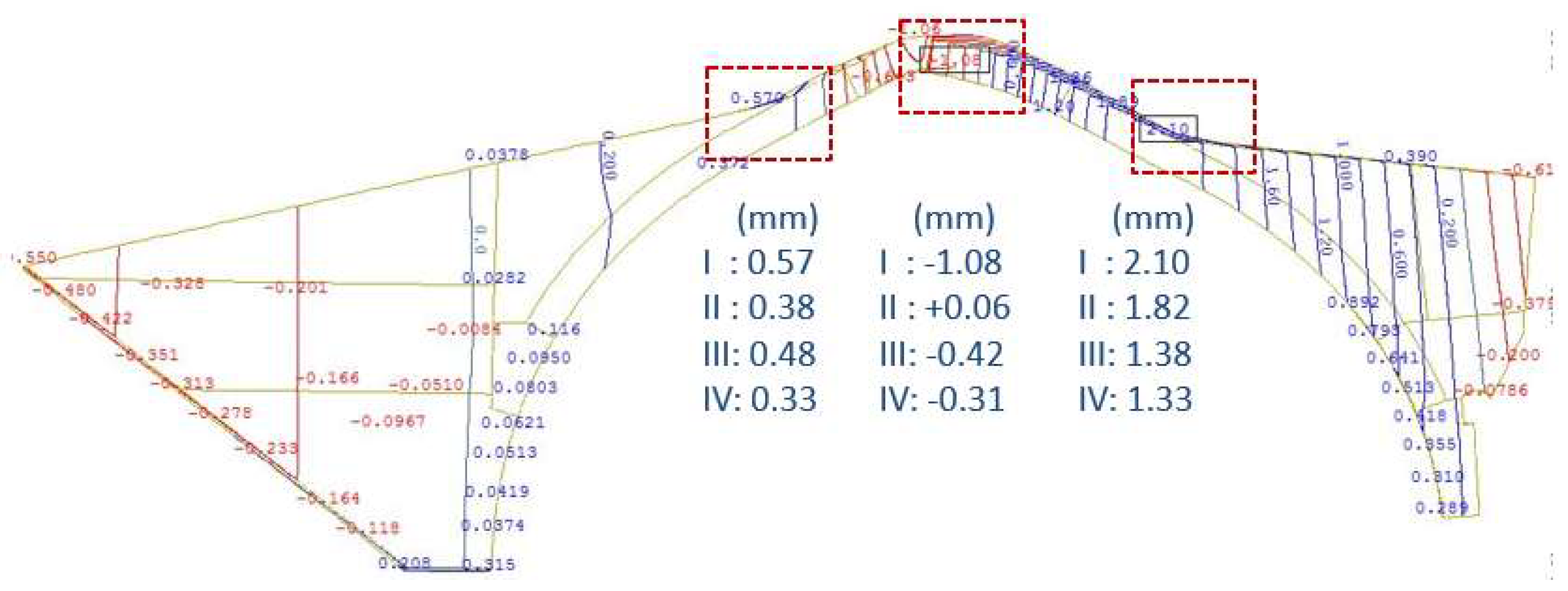


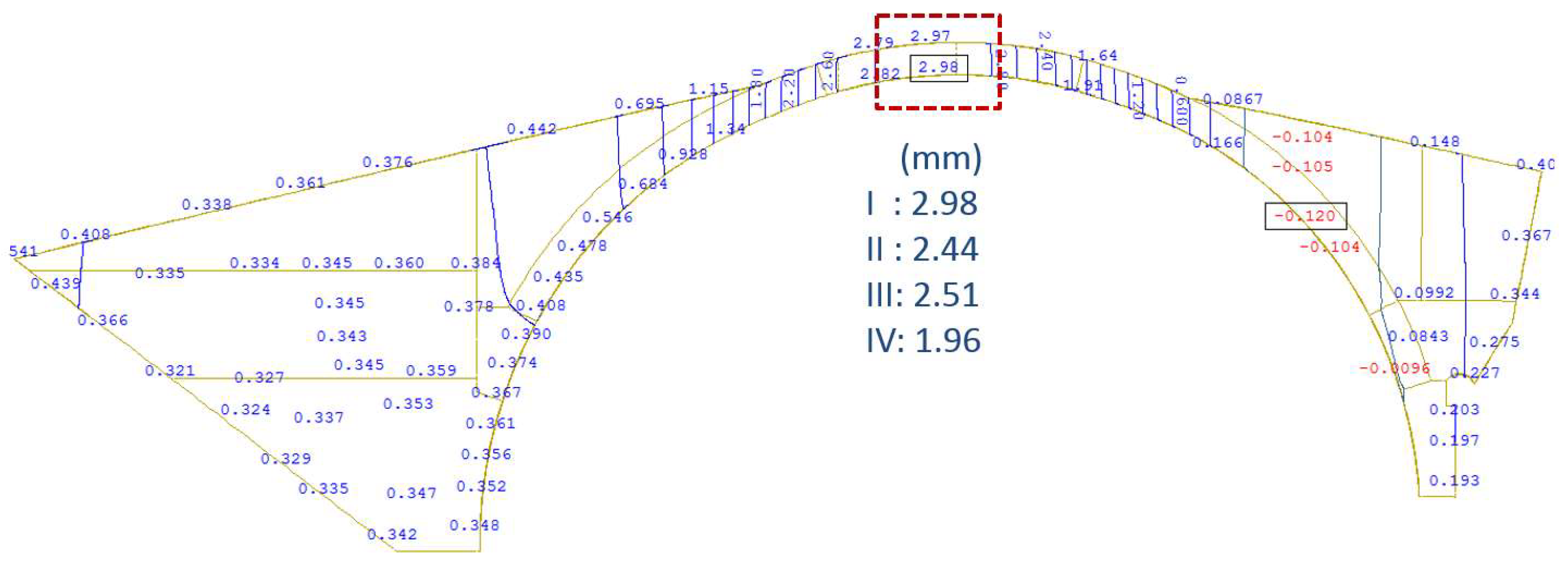
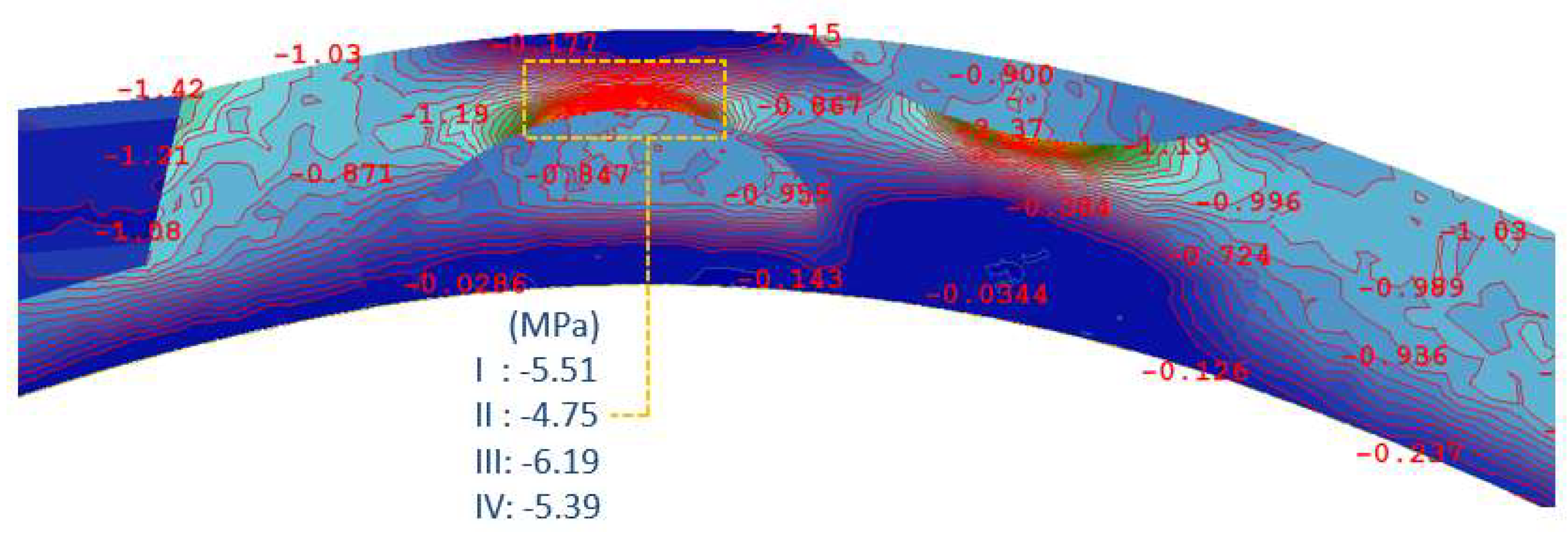
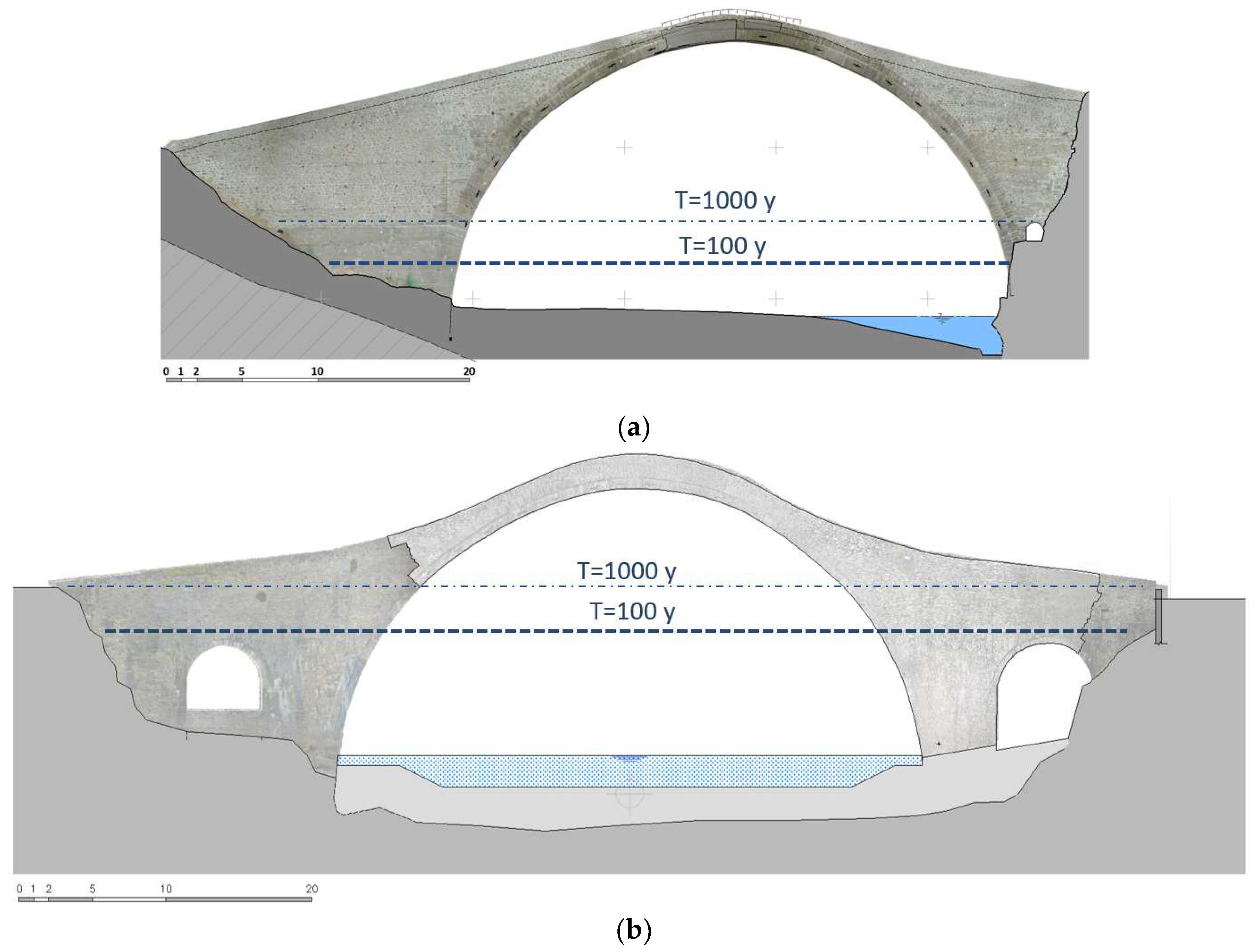
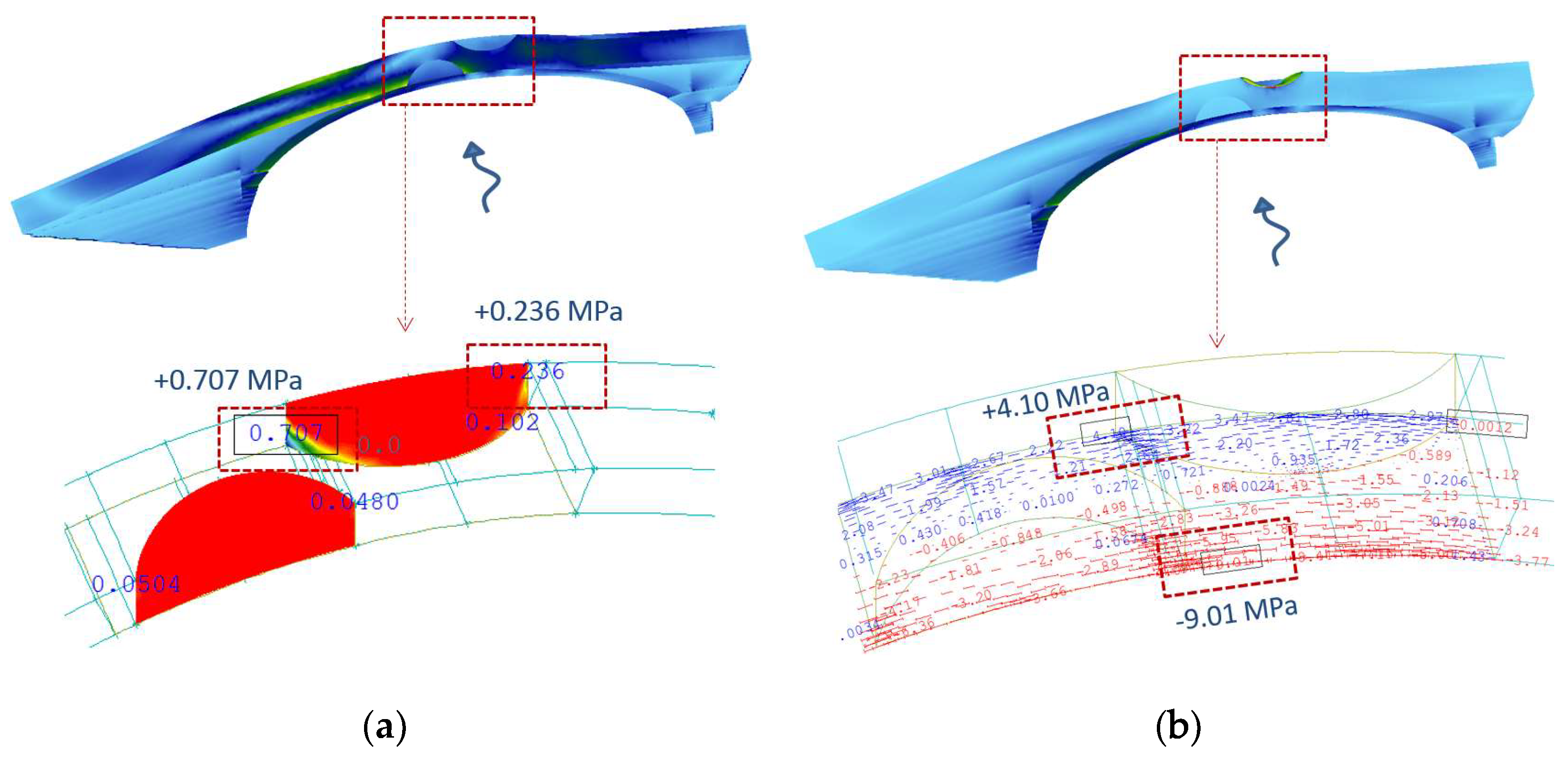
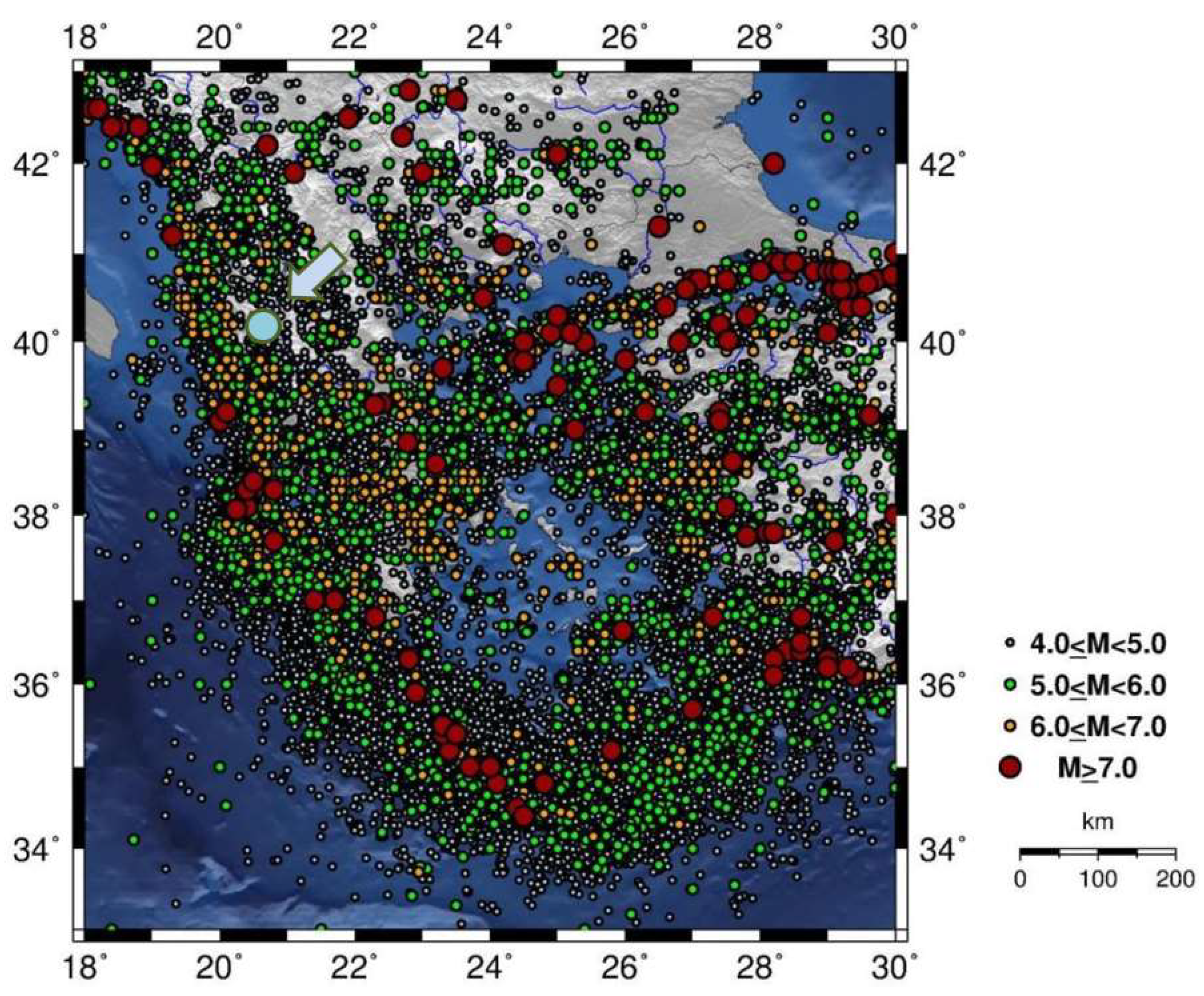

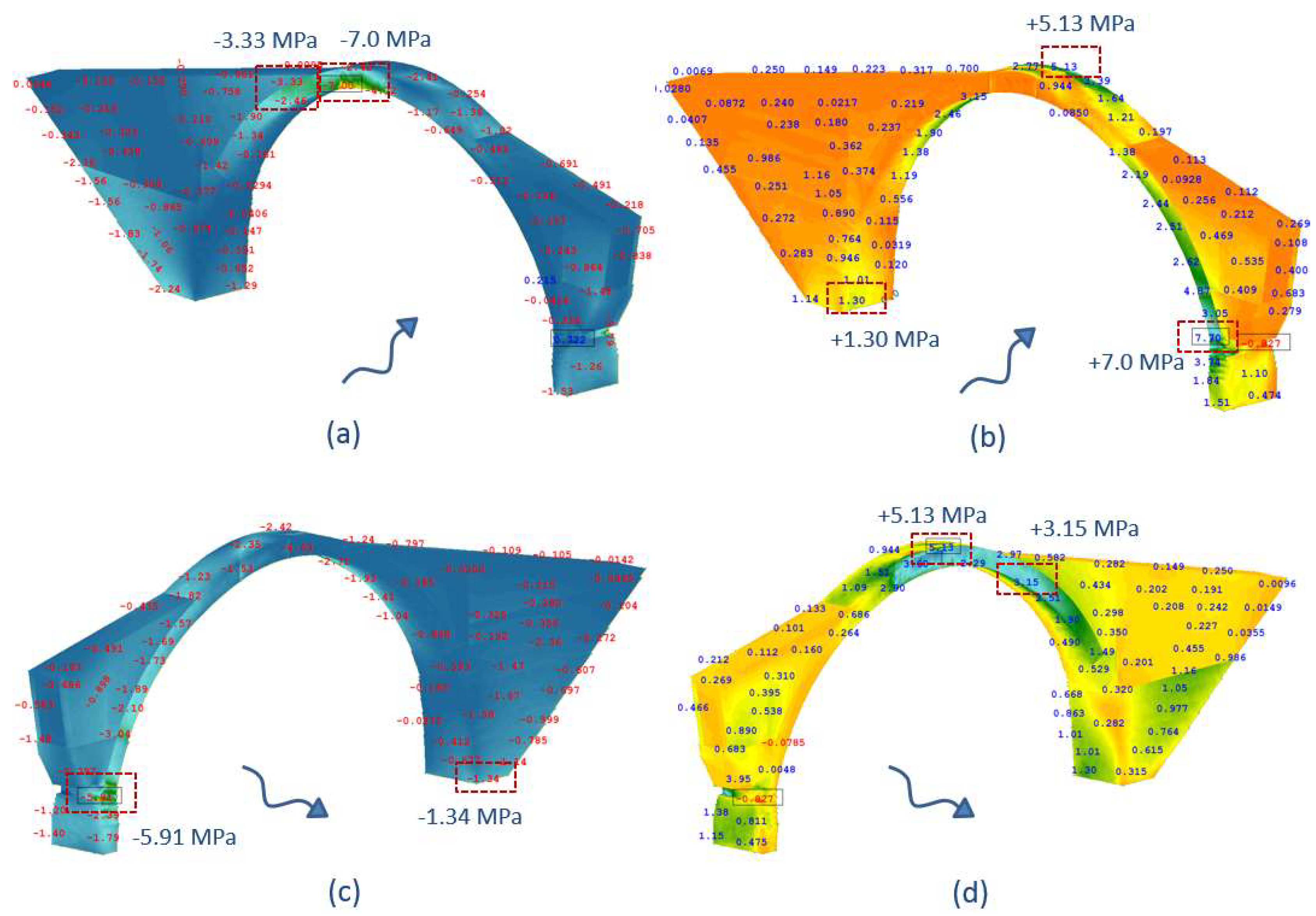
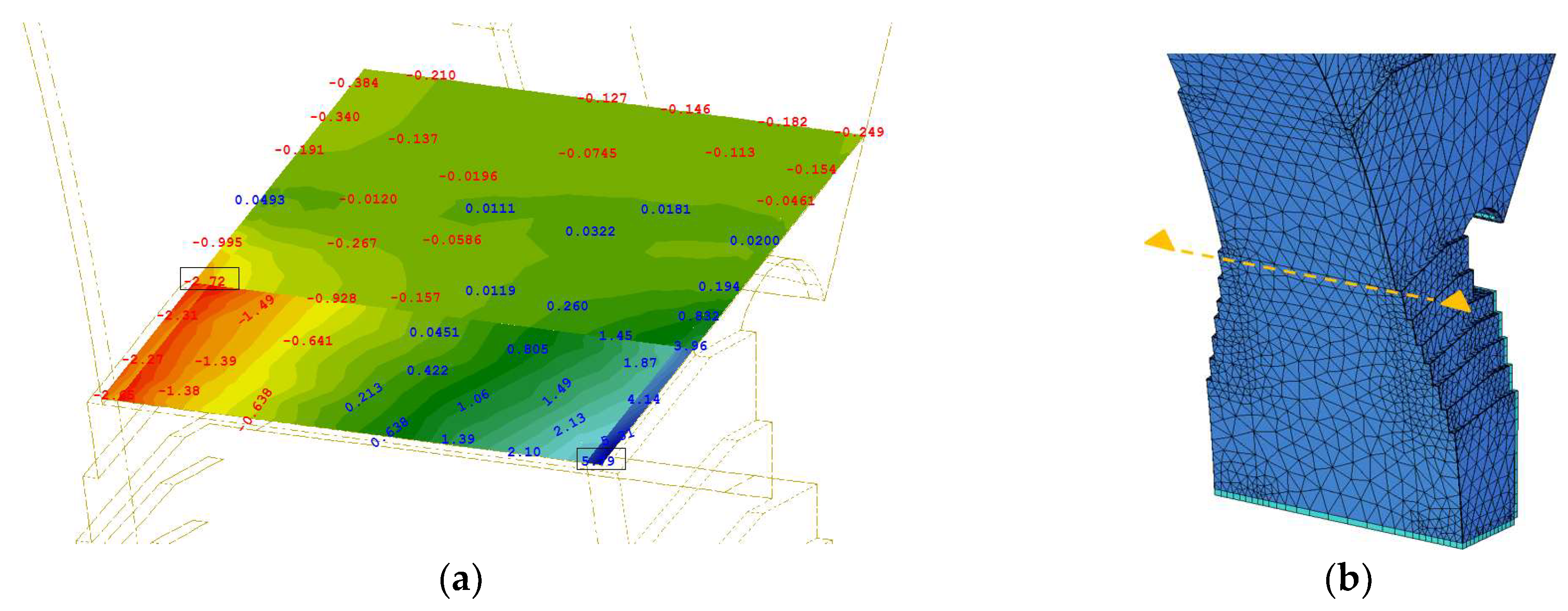
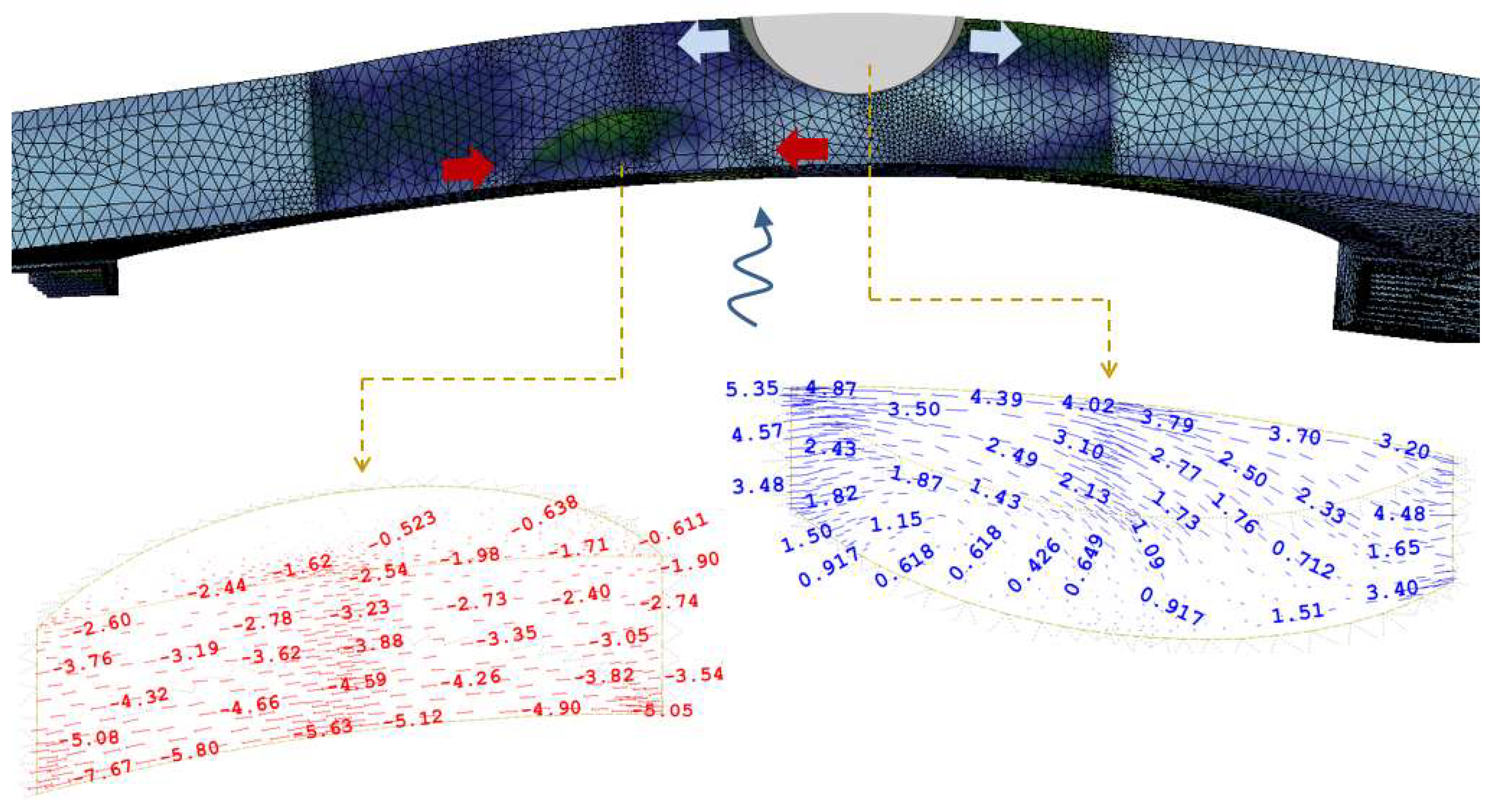
| Region Number | Area | Modulus of Elasticity (MPa) | Mean Compressive Strength fwc (MPa) |
|---|---|---|---|
| 1 | Arch | 5350 8900 | 8.90 |
| 2 | Abutments | 8700 14,500 | 14.50 |
| 3 | Spandrel walls | 1500 2500 | 2.50 |
| 4 | Filling material | 500 800 | 0.80 |
| 5 | Concrete | 27,400 | 20 |
| Case | Modulus of Elasticity of Masonry (Regions 1 to 4) (MPa) | Modulus of Subgrade Reaction (Soft “S” or Medium “M” Soil) (kN/m2) |
|---|---|---|
| I | min: E1 = 8700, E2 = 5350, E3 = 1500, E4 = 500 | S: Kv,south = 40,000, Kv,north = 100,000 |
| II | min: E1 = 8700, E2 = 5350, E3 = 1500, E4 = 500 | M: Kv,south = 120,000, Kv,north = 300,000 |
| III | max: E1 = 14,500, E2 = 8900, E3 = 2500, E4 = 800 | S: Kv,south = 40,000, Kv,north = 100,000 |
| IV | max: E1 = 14,500, E2 = 8900, E3 = 2500, E4 = 800 | M: Kv,south = 120,000, Kv,north = 300,000 |
| Phase | Description—Structural Model | Documentation Reference | |
|---|---|---|---|
| Phase 1 | Construction phase: construction of abutments |  (*) | |
 | |||
| Phase 2 | Construction phase: construction of the central region of the arch. Bridge completed. | 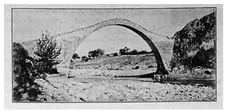 The bridge at the beginning of the 20th century (**) | |
 | |||
| Phase 3 | Damaged bridge (1913) |  Rhomaides-Zeitz, 1913 [29] | |
 |  | ||
| Phase 4 | Repaired bridge (1913) | 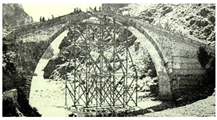 Fr. Boissonnas, 1913 [37]  RC jacket is shown in its current state | |
 |  | ||
Disclaimer/Publisher’s Note: The statements, opinions and data contained in all publications are solely those of the individual author(s) and contributor(s) and not of MDPI and/or the editor(s). MDPI and/or the editor(s) disclaim responsibility for any injury to people or property resulting from any ideas, methods, instructions or products referred to in the content. |
© 2024 by the authors. Licensee MDPI, Basel, Switzerland. This article is an open access article distributed under the terms and conditions of the Creative Commons Attribution (CC BY) license (https://creativecommons.org/licenses/by/4.0/).
Share and Cite
Giannelos, C.; Palieraki, V.; Oikonomopoulou, E.; Vintzileou, E. The Rehabilitation of the Historical Bridge of Konitsa, Epirus, Greece: A Documentation-Based Methodology of Structural Analysis and Rehabilitation Strategy. Buildings 2024, 14, 690. https://doi.org/10.3390/buildings14030690
Giannelos C, Palieraki V, Oikonomopoulou E, Vintzileou E. The Rehabilitation of the Historical Bridge of Konitsa, Epirus, Greece: A Documentation-Based Methodology of Structural Analysis and Rehabilitation Strategy. Buildings. 2024; 14(3):690. https://doi.org/10.3390/buildings14030690
Chicago/Turabian StyleGiannelos, Christos, Vasiliki Palieraki, Erato Oikonomopoulou, and Elizabeth Vintzileou. 2024. "The Rehabilitation of the Historical Bridge of Konitsa, Epirus, Greece: A Documentation-Based Methodology of Structural Analysis and Rehabilitation Strategy" Buildings 14, no. 3: 690. https://doi.org/10.3390/buildings14030690
APA StyleGiannelos, C., Palieraki, V., Oikonomopoulou, E., & Vintzileou, E. (2024). The Rehabilitation of the Historical Bridge of Konitsa, Epirus, Greece: A Documentation-Based Methodology of Structural Analysis and Rehabilitation Strategy. Buildings, 14(3), 690. https://doi.org/10.3390/buildings14030690






